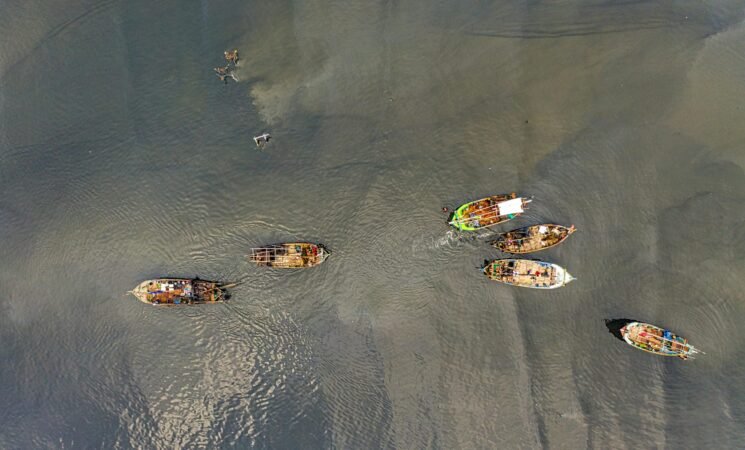21 August 2025, NIICE Commentary 11609
Titiksha Chakraborty
Shared Geography & Trade Dependence
The littoral countries of South Asia- India, Sri Lanka, Bangladesh, Maldives, and Pakistan were united by a common coastline that had provided the deep interconnections through maritime routes. With Europe, North Americ,a and East Asia, the shipping and maritime industries of the region form the linkage between production and consumer centres. Aggregate merchandise exports in these coastal South Asian countries were at USD 528 billion in 2023. Ports such as Colombo are also significant transshipment ports as they process more than 15 percent of the portion of transshipment across the South Asian region due to their location at the East-West Main Sea Route in the Indian Ocean.
The region is estimated to carry 75 percent of its international trade by value by sea. Yet intraregional trade is low-only about 5 percent, as compared to the case of ASEAN, where over 25 percent of their trade is intraregional. The value of the intraregional trade among South Asian countries lies at about USD 23 billion, which is significantly lower than the estimated potential of USD 67 billion growth-wise, the South Asian region is, however, already on track to achieve potential goals with an annual compound growth of nearly 11 per cent since the year 2000.
Countries that lack access to maritime routes like Nepal, Bhutan, and Afghanistan, have a significant dependence on the Indian and Bangladesh ports to access sea routes-indicating that economic integration in South Asia depends closely on a sustainable and safe blue economy.
South Asian Blue Economy Inequality
India has a powerful role to play in the blue economy discourse, which is supported by its large coastline, maritime armed forces, and visions such as SAGAR (“Security and Growth for all in the Region”). The smaller countries, especially the Maldives and Sri Lanka, have a high reliance on fisheries and tourism, but do not have enough resources to address the overfishing, climate resilience, and external structures of these countries. As an example, the Hambantota port in Sri Lanka, funded by China, ultimately resulted in a 99-year concession to China, which is evidence of structural imbalance. This begs a serious question of whether India is playing the role of a regional partner to the inclusive growth of blue economies, or whether its domination will move towards hegemony?
Environmental Vulnerabilities in South Asia
A number of South Asian coasts suffer critical environmental risks. Bangladesh is vulnerable to destructive cyclones; the Maldives has to contend with sea level rise, and Sri Lanka with erosion along the coast. Meanwhile, the development efforts of India, such as offshore drilling and enlarging ports, proper waste disposal, among others-do have consequences on the sea environment in the whole region. Therefore, although it is true that South Asia is inherently a risk environment, the development of its blue economy may not bring about shared regional gain, as there is little to no commensuration between vulnerability and benefits.
Indian Ocean geopolitics
India embeds its blue economy vision in SAGAR with a view to making it inclusive and grounded in sustainability, amongst other things. This is because the blue economy concept was created in several ways that undermine its vision as an inclusive and sustainable model. But, China is developing an alternate paradigm that is based on infrastructure and strategic links, the so-called string of pearls, which is epitomized on the ground by Hambantota in Sri Lanka and Gwadar in Pakistan under the CPEC umbrella.
That is the larger force at work in South Asia: the region is put in contact between India, whose maritime diplomacy is strongly centred on sustainability, and China, whose presence is based on an infrastructure-driven approach. In such an environment, the smaller states of South Asia find themselves at a crossroads, having to decide on diverse economic and security models.
Regional Cooperation Platforms
There is a set of institutional arrangements to support cooperation in the blue economy space. Notably, the Indian Ocean Rim Association (IORA), of which a blue economy working committee has been operating since 2014, is concerned with the sustainable socio-economic growth through fishing, renewable energy, environmental protection, and infrastructure development, among others. BIMSTEC (Bay of Bengal Initiative for Multi-Sectoral Technical and Economic Cooperation), and IORA have institutionalised collaboration in signing a 2025 MoU to collectively work on blue economy and maritime connectivity issues.
India is also a key member of IONS, SAARC, Indo-Pacific Oceans Initiative, Quad, and other regional platforms on maritime security and cooperation. These platforms infer that the blue economy may provide an opportunity unavailable so far: a feasible, cross-border avenue of collaboration in otherwise divided South Asia.
Nepal’s Position
Nepal is a landlocked country, depending on the efficient Indian maritime infrastructure to increase its trade security. The transit trade framework signed in June 2023 provides Nepal with better access to Indian seaports by road, rail, and inland waterways, pipeline, and digital-payment MoUs- acquiring trade resilience. Nepal is also interested in gaining access to other ports in India, like Mundra and Dhamra, beyond their traditional access through Kolkata/Visakhapatnam.
However, this reliance makes Nepal vulnerable; technical failure in Indian ports (or a change in policy like the denial of a trans-shipment facility to Bangladesh through India) can cripple it in terms of trade and economic prosperity. To counter, Nepal can further develop its “inland blue economy” by building upon hydropower, regional waterways, and cross-border infrastructure to lessen chokepoint vulnerability and create the ability to diversify its connectivity map.
The Twists Brought Together
The sustainability sticker on India's blue economy seems solid, though in South Asia, it also serves as a tool of power projection, which leaves smaller players vulnerable to climate risks and at the mercy of Indian infrastructure. The concept of the blue economy can provide a potential platform for integration in the South Asian region, although historical political tensions are most likely to hijack it as another arena of competition. South Asia had old maritime links with the Indian Ocean. Recapturing indigenous regional maritime collaboration may decolonize the rules of trade- but hegemonic strategies today threaten to reproduce extractive, uneven patterns.
Conclusion
The futures of the economies and the environment of South Asia will always be associated with the future of the blue economy. The hegemonic position of India poses a threat of power imbalance as well as the benefits of integration in the region. To make a reality sustainable, inclusive growth, such platforms as IORA and BIMSTEC need to transcend institutional mitigation to equitable execution, which may require small states, especially landlocked states such as Nepal, to invest strategically in alternative resources, such as inland blue economy assets, to balance out.
The region will have to choose: will the blue economy form a connective tissue or a new fault line between prosperity and dependency?
Titiksha Chakraborty is a Research Intern at NIICE, currently pursuing her M.A.in Political Science at the University of Delhi. India.

